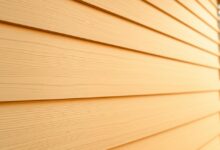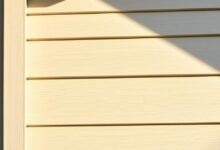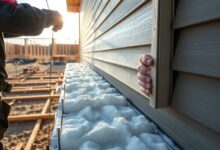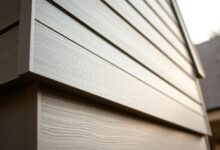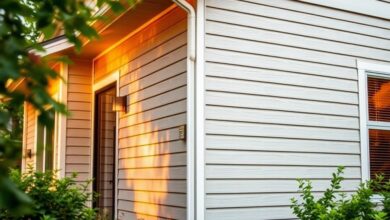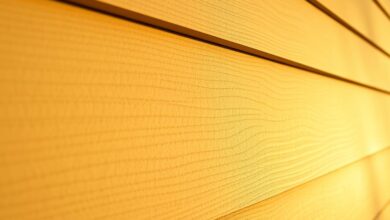Find the Best Siding for Home Insulation: Our Top Picks
Choosing the right siding for your home is key for keeping energy costs down. The right siding keeps your home warm in winter and cool in summer. It acts as a shield against the weather.
Energy-efficient siding boosts your home’s insulation and helps the planet. By picking the right siding, you can cut down on energy bills. Plus, your home will feel more comfortable.
Key Takeaways
- Proper siding improves home insulation and energy efficiency.
- Energy-efficient siding reduces energy costs.
- The right siding enhances your home’s comfort and sustainability.
- Various siding materials offer different insulation benefits.
- Choosing the best siding depends on your home’s specific needs.
The Science of Home Insulation and Siding
Home insulation and siding are key to keeping your home warm and saving energy. They work together to make your home more energy-efficient. Knowing how they interact is important.
How Siding Contributes to Overall Home Efficiency
Siding does more than just look good; it protects your home from the outside. Insulated siding is a big help in keeping your home’s temperature steady. It stops heat from moving in and out too much.
Understanding R-Values and Thermal Barriers
The R-Value shows how well insulation keeps heat out. The higher the R-Value, the better the insulation. Thermal barriers, like insulated siding, cut down on heat loss and gain.
Climate Considerations for Siding Selection
What works for one climate might not work for another. In cold places, you need siding with high R-Values. In warm areas, reflective siding can save on cooling costs. Picking the right siding depends on your local weather.
The Best Siding for Home Insulation: Evaluation Criteria
Choosing the right siding for home insulation is complex. It requires looking at several key factors. Homeowners need to check the thermal performance, durability, and cost of different options.
Thermal Performance Measurements
Thermal performance is key for good insulation. It’s measured by the R-value, showing how well a material stops heat flow. Higher R-values mean better insulation.
Durability and Weather Resistance
Durability and weather resistance are also important. Siding must handle rain, snow, and extreme temperatures well. It’s best if it lasts long and needs little upkeep.
Cost vs. Long-Term Energy Savings
The upfront cost of siding matters, but so does long-term energy savings. Some materials might cost more at first. Yet, they can save a lot on energy over time.
| Siding Material | R-Value | Durability | Cost |
|---|---|---|---|
| Vinyl Siding | 0.5-1.0 | Medium | $3-$7 per sqft |
| Fiber Cement Siding | 0.2-0.5 | High | $5-$10 per sqft |
| Insulated Metal Siding | 2.0-4.0 | High | $7-$12 per sqft |
Vinyl Siding Options for Energy Efficiency
Vinyl siding is a top pick for boosting your home’s energy efficiency. It comes in many styles, helping you cut down on energy use and bills.
Standard vs. Insulated Vinyl Siding
Standard vinyl siding offers basic protection from the weather. But insulated vinyl siding adds foam insulation for better performance. This can significantly improve your home’s heat control, keeping it warmer in winter and cooler in summer.
In areas with big temperature swings, insulated vinyl siding is a game-changer. It helps keep your home’s temperature steady and lowers your energy bills.
Installation Best Practices for Maximum Insulation
Getting your vinyl siding installed right is key to its energy-saving benefits. This means aligning it properly and fastening it tightly to the sheathing. Any gaps or loose spots can weaken its insulation.
Expected Lifespan and Performance
Vinyl siding, and insulated types in particular, is built to last. With the right care, it can go decades without needing a replacement. This makes it a smart choice for saving energy over time.
Not only will you save on energy, but you’ll also spend less on upkeep. So, vinyl siding is a cost-effective option for the long haul.
Fiber Cement Siding: Premium Insulation Choice
Fiber cement siding is a top choice for those looking for premium insulation. It’s made from cement, sand, and cellulose fibers. This mix gives it a strong and energy-saving exterior.
Thermal Properties and Performance
Fiber cement siding is great at keeping your home warm or cool. It blocks heat from moving between inside and outside. This makes your home more comfortable and saves on energy costs.
Combining with Insulation Boards
Pairing fiber cement siding with insulation boards boosts energy efficiency. Proper installation is essential to get the most out of this combo.
Maintenance Requirements for Longevity
Regular care is vital for fiber cement siding to last long. You should check for damage often, repaint every 10-15 years, and seal it well.
“Regular maintenance not only extends the life of fiber cement siding but also maintains its appearance and performance over time.”
Knowing the benefits and upkeep of fiber cement siding helps homeowners choose wisely. This choice can make their homes more energy-efficient and comfortable.
Wood and Engineered Wood Siding Solutions
Wood and engineered wood are top picks for siding. They offer natural insulation and last a long time. People love them for keeping homes warm and looking good.
Natural Insulation Properties of Cedar and Pine
Cedar and pine are favorites for siding. Cedar fights off moisture and keeps heat out. Pine is cheaper but just as good at keeping warm.
The oils in cedar and pine make them strong. They don’t get damaged easily by the weather.
Engineered Wood: Modern Insulation Improvements
Engineered wood siding is better than old wood. It’s made by layering wood fibers. This makes it less likely to warp and keeps it warm.
- Improved dimensional stability
- Enhanced thermal performance
- Reduced maintenance requirements
Proper Installation Techniques for Energy Efficiency
Getting wood or engineered wood siding right is key. It must be sealed well and have no air leaks.
| Installation Technique | Energy Efficiency Benefit |
|---|---|
| Tight Sealing | Reduces air leakage |
| Proper Alignment | Prevents water intrusion |
| Insulation Backing | Enhances thermal performance |
Choosing the right wood or engineered wood siding is important. Make sure it’s installed right. Then, you’ll get the looks and warmth you want.
Metal and Composite Siding Insulation Performance
The insulation of metal and composite siding is key in modern homes. Homeowners want energy-efficient homes, making these materials popular. They help keep homes warm in winter and cool in summer.
Metal siding, like insulated steel and aluminum, is durable and saves energy. Its insulation cuts down on heat transfer. This keeps homes comfortable all year.
Insulated Steel and Aluminum Options
Insulated steel siding has insulation between two steel sheets. It’s warm in winter and cool in summer. Aluminum siding is light and doesn’t rust, great for coastal homes.
| Material | Thermal Performance | Durability |
|---|---|---|
| Insulated Steel | High | Excellent |
| Aluminum | Good | Very Good |
Composite Materials: The Best of Both Worlds
Composite siding mixes materials for durability, looks, and warmth. It looks like wood but doesn’t need much upkeep.
Composite materials fight thermal bridging. This is when metal conducts heat, lowering insulation’s effect.
Addressing Thermal Bridging Concerns
Manufacturers have found ways to stop thermal bridging. They use insulation breaks or thermal barriers in siding. This keeps insulation working well.
Knowing how metal and composite siding insulate helps homeowners choose. They consider energy savings, durability, and cost.
Cost Analysis and ROI of Insulated Siding
Insulated siding has many benefits, but it’s important to look at the cost and ROI. Homeowners need to think about the upfront cost and the long-term energy savings. This helps understand the financial side fully.
Initial Investment vs. Energy Savings
The cost of insulated siding is often higher than other siding types. But, the energy savings over time can make up for this. For example, insulated vinyl siding can cut heating and cooling costs by up to 20%.
| Siding Type | Initial Cost | Annual Energy Savings | Payback Period |
|---|---|---|---|
| Insulated Vinyl Siding | $10,000 | $200 | 10 years |
| Insulated Fiber Cement Siding | $15,000 | $300 | 12 years |
Tax Credits and Incentives for Energy-Efficient Siding
Many governments give tax credits and incentives for energy-efficient siding. These can lower the upfront cost and boost the ROI. It’s key to check out what’s available in your area.
Calculating Your Break-Even Point
To find your break-even point, divide the total siding cost by the yearly energy savings. For example, if the total cost is $12,000 and you save $250 a year, it takes 48 years to break even. Knowing this helps homeowners make better choices.
Conclusion: Selecting the Right Insulated Siding for Your Home
Choosing the right insulated siding for your home is key. It affects energy use, cost, and how long it lasts. Different siding types, like vinyl, fiber cement, wood, and metal, have their own pluses and minuses.
Think about how well it keeps heat, withstands weather, and how easy it is to care for. Insulated siding can cut down on energy use, saving you money over time. Look into tax breaks and other incentives to help with the cost.
Knowing what each siding material does and how it insulates helps you decide. Pick siding that fits your climate and budget. The best choice will make your home cozier, lower your bills, and boost its value.
